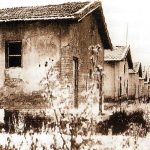In the 19th century, the main routes of the community of Laterina were the Via Vecchia Aretina and the Regia Postale Aretina road. However, after the unification of Italy and the construction of the railway line between Montevarchi and Arezzo, the process of economic development was marginalized in those areas, affecting Laterina’s territory only partially. The growth primarily benefited the districts of Ponticino and Montalto, thanks to the establishment of railway stations.The economy was mainly based on agriculture and large estates, with land worked under sharecropping. Specialist crops, such as tobacco, were introduced for the first time, leading to the construction of numerous brick tobacco drying houses. These were large buildings, developed in depth with basilica-style facades, used for drying tobacco in the early 20th century.
During World War II, between the Via Vecchia Aretina and the Arno River, a concentration camp was established in 1941 to house prisoners from the enemy belligerent forces (primarily British soldiers captured in North Africa). The camp consisted of masonry barracks arranged in blocks, and it operated as such until September 8, 1943. Afterward, it became a German mechanical workshop for the repair of transport vehicles. Following the liberation (July 18, 1944), the camp was used by the British to gather German and fascist prisoners. Then, between 1945 and 1946, it housed fascist and republican internees captured in Northern Italy. From 1948 to 1963, the site became a center for the collection of refugees from Istria, Libya, and Tunisia.
Starting from the post-war period, the phenomenon of depopulation of the countryside, which had already begun in the 1960s, led to the gradual abandonment of farmhouses, many of which are now unfortunately reduced to ruins. The landscape was further altered by the construction of the direct Florence-Rome railway line (built between 1985 and 1988). However, thanks to the interest of both public and private institutions, some farmhouses and the tobacco drying house of Monsoglio have been restored for agritourism purposes.





